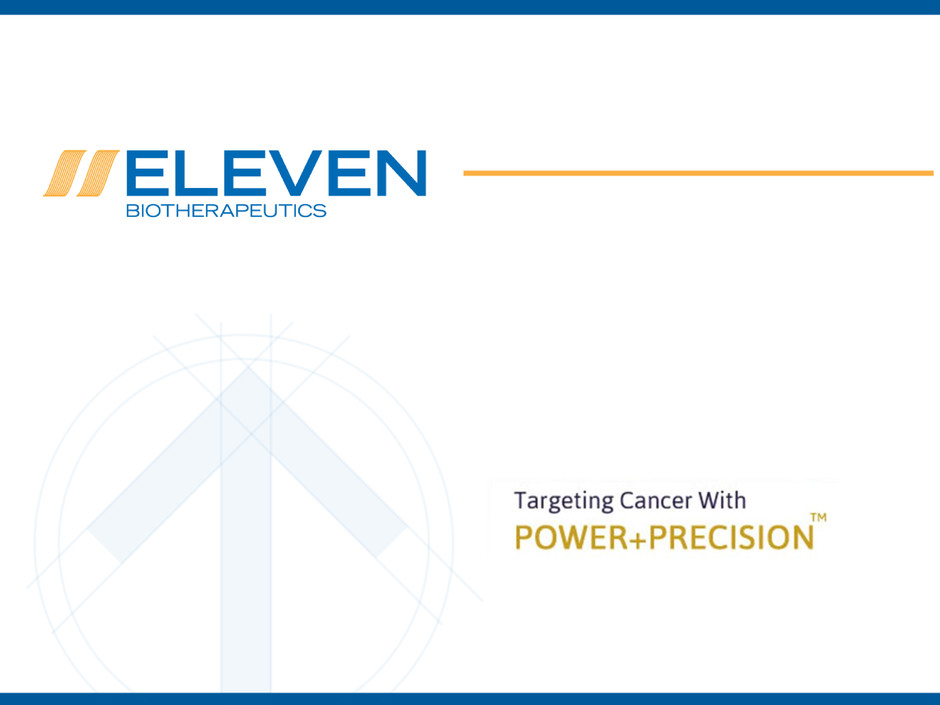Attached files
| file | filename |
|---|---|
| 8-K - 8-K - Sesen Bio, Inc. | ebio-8xk2017corporateprese.htm |

January 2017
Corporate Overview
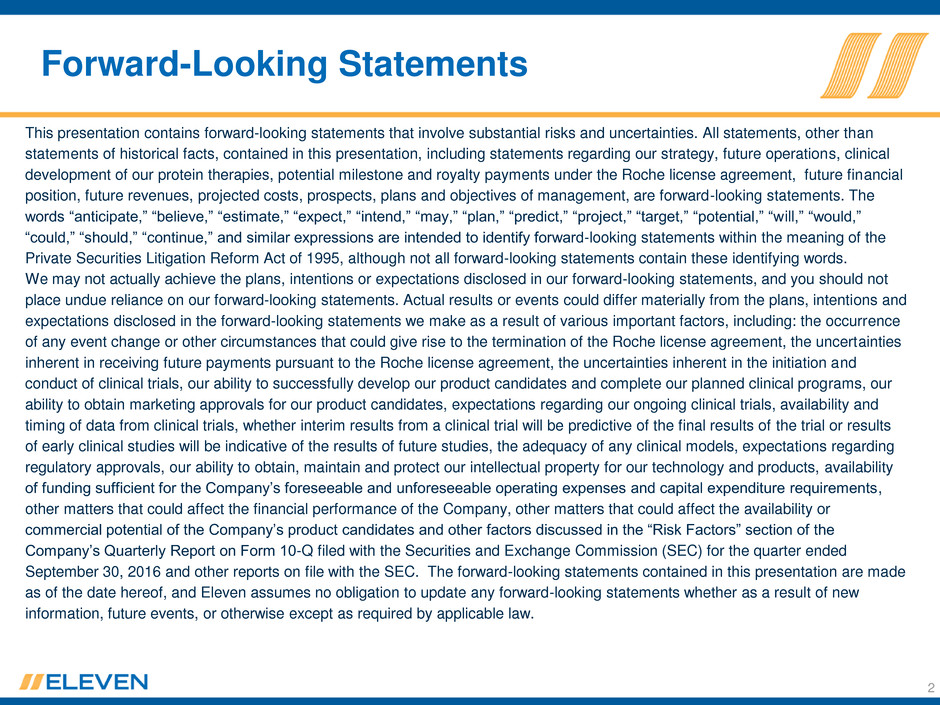
This presentation contains forward-looking statements that involve substantial risks and uncertainties. All statements, other than
statements of historical facts, contained in this presentation, including statements regarding our strategy, future operations, clinical
development of our protein therapies, potential milestone and royalty payments under the Roche license agreement, future financial
position, future revenues, projected costs, prospects, plans and objectives of management, are forward-looking statements. The
words “anticipate,” “believe,” “estimate,” “expect,” “intend,” “may,” “plan,” “predict,” “project,” “target,” “potential,” “will,” “would,”
“could,” “should,” “continue,” and similar expressions are intended to identify forward-looking statements within the meaning of the
Private Securities Litigation Reform Act of 1995, although not all forward-looking statements contain these identifying words.
We may not actually achieve the plans, intentions or expectations disclosed in our forward-looking statements, and you should not
place undue reliance on our forward-looking statements. Actual results or events could differ materially from the plans, intentions and
expectations disclosed in the forward-looking statements we make as a result of various important factors, including: the occurrence
of any event change or other circumstances that could give rise to the termination of the Roche license agreement, the uncertainties
inherent in receiving future payments pursuant to the Roche license agreement, the uncertainties inherent in the initiation and
conduct of clinical trials, our ability to successfully develop our product candidates and complete our planned clinical programs, our
ability to obtain marketing approvals for our product candidates, expectations regarding our ongoing clinical trials, availability and
timing of data from clinical trials, whether interim results from a clinical trial will be predictive of the final results of the trial or results
of early clinical studies will be indicative of the results of future studies, the adequacy of any clinical models, expectations regarding
regulatory approvals, our ability to obtain, maintain and protect our intellectual property for our technology and products, availability
of funding sufficient for the Company’s foreseeable and unforeseeable operating expenses and capital expenditure requirements,
other matters that could affect the financial performance of the Company, other matters that could affect the availability or
commercial potential of the Company’s product candidates and other factors discussed in the “Risk Factors” section of the
Company’s Quarterly Report on Form 10-Q filed with the Securities and Exchange Commission (SEC) for the quarter ended
September 30, 2016 and other reports on file with the SEC. The forward-looking statements contained in this presentation are made
as of the date hereof, and Eleven assumes no obligation to update any forward-looking statements whether as a result of new
information, future events, or otherwise except as required by applicable law.
Forward-Looking Statements
2

Recent Developments
• Eleven Biotherapeutics (Eleven) is a clinical stage company engineering and
developing protein-based therapeutics for human disease
• On August 16th, 2016 Eleven completed an exclusive licensing deal for EBI-
031 with Roche
‒ EBI-031 is a humanized monoclonal antibody that potently binds interleukin-6 (IL-6) and
inhibits all known forms of IL-6 cytokine signaling
‒ Received $30 million in upfront and milestone payments
‒ Could receive up to an additional $240 million upon the achievement of certain future
regulatory, development and commercialization milestones
• $20M milestone on initiation of a Phase 2 study
‒ Entitled to receive tiered royalties with rates for net sales of potential future products
containing EBI-031 and 50% of these rates of any other potential future products containing
other Eleven IL-6 compounds.
‒ Buy Out Options:
• Before start of Ph 3: $135 million
• Before BLA Filing: $265 million (EU COM IP)
$220 million (No EU COM IP)
• On September 20th, 2016 Eleven acquired Viventia Bio Inc. (Viventia)
3
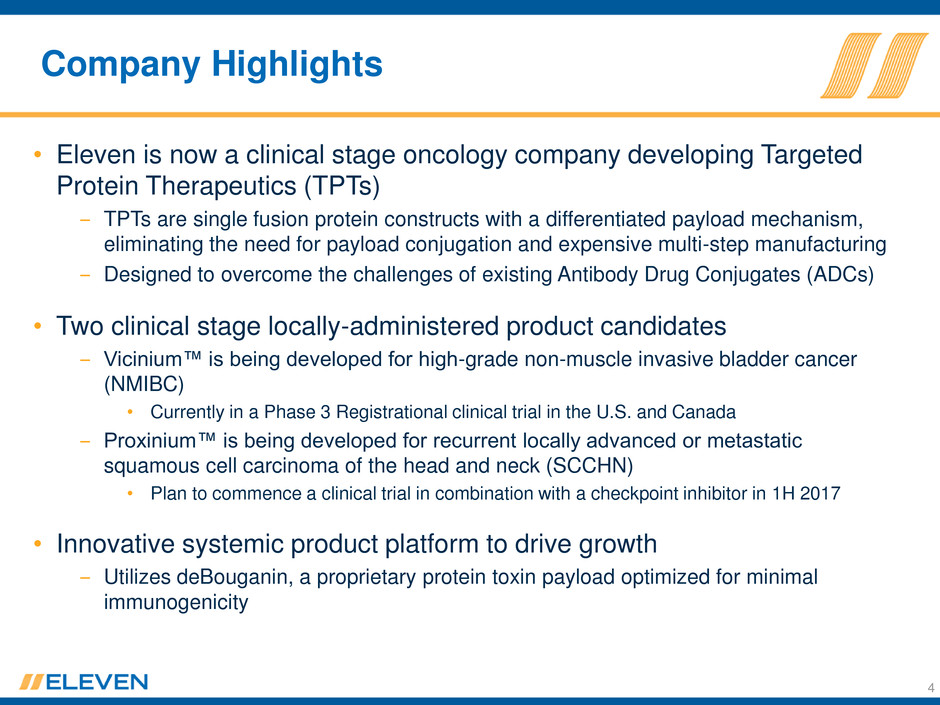
Company Highlights
• Eleven is now a clinical stage oncology company developing Targeted
Protein Therapeutics (TPTs)
‒ TPTs are single fusion protein constructs with a differentiated payload mechanism,
eliminating the need for payload conjugation and expensive multi-step manufacturing
‒ Designed to overcome the challenges of existing Antibody Drug Conjugates (ADCs)
• Two clinical stage locally-administered product candidates
‒ Vicinium™ is being developed for high-grade non-muscle invasive bladder cancer
(NMIBC)
• Currently in a Phase 3 Registrational clinical trial in the U.S. and Canada
‒ Proxinium™ is being developed for recurrent locally advanced or metastatic
squamous cell carcinoma of the head and neck (SCCHN)
• Plan to commence a clinical trial in combination with a checkpoint inhibitor in 1H 2017
• Innovative systemic product platform to drive growth
‒ Utilizes deBouganin, a proprietary protein toxin payload optimized for minimal
immunogenicity
4

Product Pipeline
Product Candidate Payload Indication Pre-clinical Ph 1 Ph 2 Ph 3
Locally-administered TPTs
Vicinium ETA
BCG refractory
high-grade NMIBC
Proxinium in combination
with Checkpoint Inhibitor
ETA Late-stage SCCHN
Systemically-administered TPTs
VB6-845d deBoug Solid tumors
Partnered Assets
EBI-031 (Roche) n/a
Diabetic Macular
Edema
5

Experienced Leadership Team
Steve Hurly
President, CEO, and Director
Arthur DeCillis, MD
Chief Medical Officer
John McCabe, CPA
Chief Financial Officer
Greg Adams, PhD
Chief Development Officer
Glen MacDonald, PhD
Chief Scientific Officer
Wendy L. Dixon, PhD
Chair
Abbie C. Celniker, PhD
Paul Chaney
Leslie L. Dan, BSc Phm, MBA, CM
Dan Lynch
Jay S. Duker, MD
Barry J. Gertz, MD, PhD
Jane V. Henderson
MANAGEMENT TEAM BOARD OF DIRECTORS
6
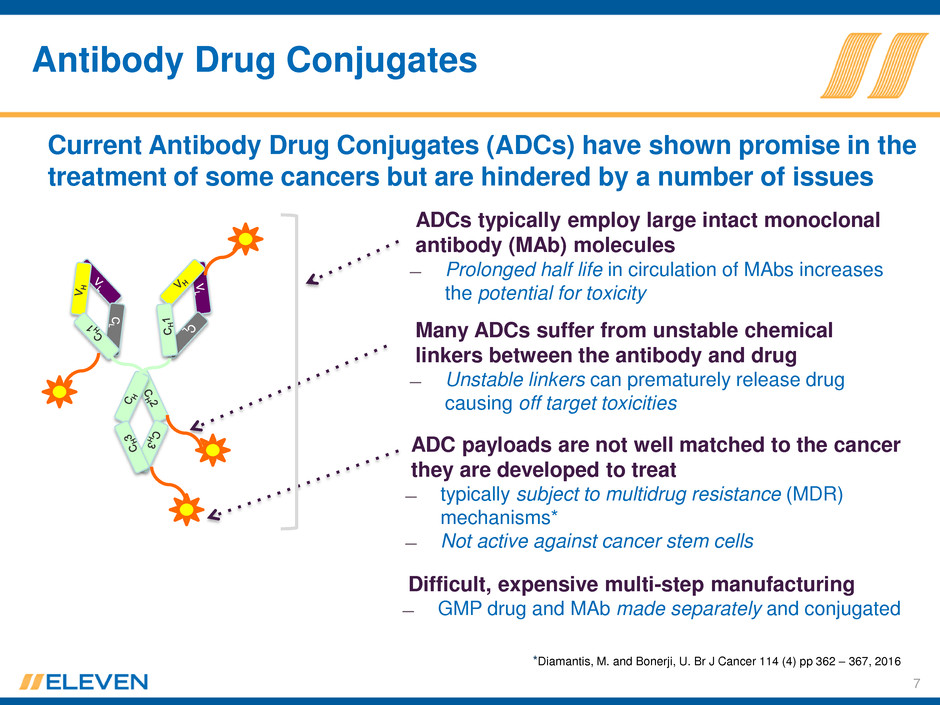
Antibody Drug Conjugates
ADC payloads are not well matched to the cancer
they are developed to treat
̶ typically subject to multidrug resistance (MDR)
mechanisms*
̶ Not active against cancer stem cells
Many ADCs suffer from unstable chemical
linkers between the antibody and drug
̶ Unstable linkers can prematurely release drug
causing off target toxicities
ADCs typically employ large intact monoclonal
antibody (MAb) molecules
̶ Prolonged half life in circulation of MAbs increases
the potential for toxicity
7
Current Antibody Drug Conjugates (ADCs) have shown promise in the
treatment of some cancers but are hindered by a number of issues
Difficult, expensive multi-step manufacturing
̶ GMP drug and MAb made separately and conjugated
*Diamantis, M. and Bonerji, U. Br J Cancer 114 (4) pp 362 – 367, 2016

TPTs Designed to Overcome Limitations and
Improve on Existing ADCs
TPTs:
• Designed to deliver a greater amount of drug to the tumor bed with deeper
penetration
‒ Engineered utilizing antibody fragments (single chains and Fabs)
• Designed to kill a broader array of cancer cells within a targeted tumor
‒ Powerful protein synthesis inhibitors designed to kill both rapidly proliferating and slower growing
cancer cells including potentially cancer “stem cells”
• May promote therapeutic immune responses
‒ Potential combinations with checkpoint inhibitors and other I/O products
‒ Unlike chemotherapy targeted to cancer - no damage to critical immune cell populations*
• Potentially improved safety profile due to stable, genetically engineered linkers -
product candidates are single proteins
‒ Designed to remain intact until internalized into targeted cancer cell
• One-step manufacturing
‒ More efficient than existing ADC manufacturing
‒ Cost-effective E. Coli system
8
*Rébé & Ghiringhelli. Future Oncol. 2015 Sep 17

Fully biologic constructs that are designed through recombination of key
components as single gene-fused proteins
One Targeting Moiety + Linker + Protein toxin
Furin
Cleavable
Non-
Cleavable
scFv
Fab Diabody
DeBouganin
ETA
(Pseudomonas Exotoxin A)
Designed for loco-regional
delivery
Vicinium and Proxinium
De-immunized toxin
designed for systemic
delivery
VB6-845d
or or
9
Fit for Purpose TPT Design

Treatment of High-Grade NMIBC
10

Vicinium: Loco-Regional Delivery
Truncated Pseud. exotoxin A (ETA)
C
̶ Binds specifically to EpCAM-positive cells
̶ Enters cell after binding to EpCAM
̶ Minimal to no EpCAM expression on normal bladder cells
̶ EpCAM over-expressed in high grade NMIBC
̶ Potent payload
̶ Requires antibody binding to
enter into a cell
̶ Induces cell death
C
Anti-EpCAM single-chain Fv antibody fragment
Single chain anti-EpCAM antibody fragment fused with
Pseudomonas exotoxin A (ETA)
11

Vicinium: Mechanism of Action
12

Vicinium: Treatment of High-Grade NMIBC
• Bladder Cancer - 2nd most common cancer of genitourinary system
‒ Ninth most common cancer diagnosed worldwide (~430,000 new patients/year)*
‒ In the U.S., bladder cancer has the highest per patient treatment costs
• Indirect costs of $184,762 to $461,907 per patient.
• Non-muscle invasive bladder cancer (NMIBC) is treated by urologists, accounts
for 70-80% of all bladder cancers
• Bacillus Calmette-Guerin (BCG) with or without transurethral resection of the
bladder tumor (TURBT) is first-line treatment for high-grade NMIBC
‒ High failure rates in high-grade disease (50% within 1 year, 90% percent within 5 years)
• Initial market opportunity is for high-grade NMIBC patients refractory to BCG
• No major advances in 40 years
*World Cancer Research Fund (http://www.wcrf.org/int/cancer-facts-figures/worldwide-dataInternational)
13

Vicinium: Treatment of High-Grade NMIBC
Expanded indications - In addition to the initial BCG refractory market, we believe Vicinium
may have applications in the following additional indications:
• Retreatment: Patients who respond to Vicinium and subsequently have a recurrence,
could potentially have a second round of Vicinium induction and maintenance therapy
• Ongoing maintenance therapy: Patients who have a CR and remain recurrence-free at 2-
years, could potentially continue maintenance therapy
• Combination therapy: Vicinium could potentially be used in combination with BCG in
second line.
• BCG has been in short supply. Though Sanofi is now back in production, they have
announced they intend to stop manufacturing BCG in 2018. Hence, Vicinium could
potentially be used first-line, after TURBT, for patients who lack access to BCG.
• Patients who are immuno-compromised are at high risk of disseminated BCG-disease.
Vicinium could potentially be used for such patients
• For patients at high risk of progression (CIS and T1), Vicinium could potentially be used in
combination with BCG in first line
14

Vicinium: Phase 1 Clinical Results
• 64 patients with Grade 2 or 3 BCG refractory or intolerant+ NMIBC*
• Trial design
• Treated weekly x 6 weeks: Dose escalation (0.1- 30.16 mg)
• Efficacy assessment: Cystoscopy, Biopsy (Random and Directed), Urine Cytology
*Source: Kowalski et. al., Drug Design, Development and Therapy 4: 313, 2010.
Safety and Exploratory Efficacy
• CIS population Complete Response (CR) rate at 3 months:
• Low dose (0.1 mg - <1.0mg): 1/6 (17%)
• High Dose (≥ 10.0mg): 4/11 (36%)
• Papillary patients:
• 19/44 (43%)
• No dose limiting toxicities (DLTs) reported. Well tolerated at these doses.
• No maximum tolerated dose (MTD) was reached.
• Only 2 subjects with detectible systemic levels (very near the LLQ). No clinical
complications
+Refractory defined as recurrence within 2 years after at least one full cycle of BGC. 5 of 64 patients were BCG intolerant
*Source: Kowalski et. al., Drug Design, Development and Therapy 4: 313, 2010
15

Vicinium: Phase 2 Clinical Results
• 46 post BCG refractory or intolerant carcinoma in situ (CIS) subjects*
• Refractory or intolerance to one or more courses of BCG in the prior 24 month
• CIS is most aggressive form, toughest to treat NMIBC population
• Induction phase: 30mg in 40mL for 6 or 12 weeks + maintenance dosing
• Maintenance cycle (1 x per week for 3 weeks) every 3 months in responders
• Primary endpoint: CR at 3 months; assessed for durability every 3 months until
12 months
*Source: Kowalski et. al., Journal of Urology, 188: 1712, 2012.
• CR rates
• 3 months: 40% (18 of 45 evaluable subjects)
• 12 months: 17% (12 week arm) and 13% (6 week arm)
• All patients that were CR at 1 year on 12 week arm remained disease-free for at
least 18 months
• Median time to recurrence: 408 days (12 wk arm) vs. 274 days (6 wk arm); p = 0.17
• No significant toxicity or tolerability issues
Safety and Exploratory Efficacy
16

Vicinium: Phase 2 Clinical Results
CIS with or without Ta, T1 CIS with or without Ta, T1
Treatment Arm B Subjects (N=20) Treatment Arm A Subjects (N=20)
6 Week Induction 12 Week Induction
73% of the non CRs showed reduction in tumor or stable disease relative
to % area affected at baseline
Increased Area Affected
n=3
Stable Disease
N=4
Partial Response
N=4
Complete Responders
N=9
% Reduction from Baseline
% Increase over Baseline
Of the 46 subjects enrolled, 27 subjects (58.7%) had failed at least two rounds of BCG treatment
*Only subjects (40/46) with baseline and 3 mos bladder map data are included
17

Adverse Events: Phase 1 and 2 Trials
• No significant toxicity or tolerability issues
‒ Generally well tolerated
‒ No subjects unable to complete treatment
• Phase 1 Trial
‒ 31% of subjects experienced an AE related to treatment
‒ 98% of all AEs were Grade 1 or 2
‒ Incidence of AEs decreased with increasing dose
‒ No treatment-related SAEs were reported
• Phase 2 Trial
‒ 65% of subjects had an AE related to treatment, % of subjects with AEs similar in both treatment
arms
‒ 6 subjects reported SAEs. None of the SAEs were determined to be related to the study drug.
• AEs regardless of causality
‒ Renal and urinary disorders were the most common adverse events
• Hematuria, dysuria, pollakiuria, micturition urgency, urinary tract infections, nocturia,
incontinence and bladder pain and spasms
‒ The most frequent systemic adverse events
• Fatigue and Dizziness
18

An Open-Label, Multicenter, Phase 3 Study to
Evaluate the Efficacy and Tolerability of Intravesical
ViciniumTM in Subjects with Non Muscle Invasive
Carcinoma in Situ (CIS) and/or High-Grade Papillary
Disease of the Bladder Previously Treated with
Bacillus Calmette Guérin (BCG)
19

Vicinium Study in Bladder Cancer (VISTA)
• Following the guidance provided by FDA, we commenced an open-label, non-
randomized Phase 3 clinical trial of Vicinium in subjects with BCG
refractory/relapsed high-grade NMIBC in the United States and Canada in Q3 2015
• Targeted to enroll 134 subjects (77 subjects with CIS) at over 65 Centers (CIS
and/or Papillary Tumors)
• Commenced Phase 3 clinical trial
• Primary endpoint: CR for CIS subjects
• Secondary endpoints include time to disease recurrence and event free survival
Sample Size 134
Patients with
BCG-
Unresponsive
High-Grade
NMIBC
Induction Phase
Weeks 1 – 6
Twice Weekly
Dosing
Weeks 7 – 12
Once Weekly
Dosing
Maintenance Phase
Up to Week 104
Every Other Week
Dosing Subjects
with no
evidence of
high-grade
disease
20

Response Evaluation
• Week 13 (Post-Induction Phase) and every 13 weeks
• Evaluation includes cystoscopy and urine cytology
• Biopsies (directed) required if suspicious lesions are found on
cystoscopy
• Random biopsies may be required if urine cytology suspicious for
high grade urothelial carcinoma
• There are no partial responses for CIS patients
21

NMIBC – Recent events
• Sanofi BCG announcement – November 17th, Sanofi plans to stop producing BCG in
mid-2017 saying it hasn’t been able to restore full production at a Toronto
manufacturing plant that had contamination problems.
• Relevance: No expected impact on Vicinium Phase 3 trial however limited
availability of first line BCG could open larger market
• In November 2016 the FDA released “BCG-Unresponsive NMIBC: Developing
Drugs and Biologics for Treatment Guidance for Industry” for comments. We
believe this guidance re-affirmed our Vicinium Phase 3 protocol. Key points:
• Confirmed single-arm open label trial with CR rate as the primary endpoint can
provide primary evidence of effectiveness to support a marketing application.
• Suggested the potential for traditional full approval instead of conditional
approval requiring a confirmatory trial post approval.
• Heat Biologics – November 30th, Presented disappointing top-line data from a Phase
II study of its lead pipeline candidate, HS-410 for the treatment of NMIBC
• Relevance: This follows Telesta’s clinical complete response letter. Both were
pursuing immune stimulatory approach versus Eleven’s targeted therapy
22

Treatment of Late-Stage SCCHN
23

Proxinium: Targeting Late-Stage Squamous
Cell Carcinoma Head & Neck
• Single chain anti-EpCAM fragment fused with ETA to treat late-stage SCCHN
• Late-stage SCCHN is dominated by the primary tumor
‒ 40-60% of deaths result from local or regional disease*
‒ 90% of patients with disseminated disease die as a result of uncontrolled disease at the primary site or in the neck**
• The annual incidence of head and neck cancers worldwide is more than 550,000
cases with around 300,000 deaths each year***
‒ 2016 estimate of 46,330 new cases of oral cavity, pharyngeal and laryngeal tumors in the U.S. with ~9,570 deaths****
• Surgery highly invasive and associated with significant morbidity
‒ Five year survival rate of only 40-50%, depending on stage of advancement
‒ Up to 70% of patients present with advanced disease
‒ Recurrent disease often not suitable for additional surgery or radiation
• Standalone chemo/biologics have limited benefit
‒ 2nd line chemotherapy median survival is 103 days**; Best Supportive Care median survival is 56 days**
• Potentially complementary to checkpoint inhibitors
*Source: Clayman & Dreiling, Injectable Modalities as Local and Regional Strategies for Head and Neck Cancer
**Source: Leon et. al. Clin Oncol 17: 418, 2005.
***Jemal et al. CA Cancer J Clin 61: 69, 2011
****American Cancer Society (http://www.cancer.org/cancer/oralcavityandoropharyngealcancer/detailedguide/oral-cavity-and-oropharyngeal-cancer-key-statistics
24

Proxinium Phase I Studies
VB4-101 VB4-101A
Location Russia Brazil
Schedule Daily x 5 Q 28 days Weekly x 4
MTD 200 µg 700 µg
N 24 20
EpCAM positive 17 18
Response Criteria –
based on target lesion(s)
• Investigator’s measurements
• Investigator’s overall assessment including
qualitative changes
• Independent 3rd party assessment of available
radiologic data
Evaluable for Response 14 16
Antitumor Activity 43% 62.5%
Dose-Limiting Toxicity LFT elevations LFT elevations
25

Proxinium: Phase 1 Clinical Trial Results
• EpCAM expression was not an inclusion criterion
• EpCAM positive subjects were 71% (Russia) and 90% (Brazil)
• None of the evaluable EpCAM-negative subjects (n=8) from either trial
responded
• Three out of the four patients with complete responses had regression or
complete resolution of noninjected lesions adjacent to the injected tumors
• Proxinium was generally well-tolerated
• Mean OS for EpCAM+ subjects was 196 days vs. 101 days for EpCAM “-”
subjects
• The results from these two Phase 1 studies suggest that Proxinium may be
effective in the treatment of EpCAM–positive SCCHN
*Source: MacDonald et. al. Drug Design, Development and Therapy 2: 105, 2008; MacDonald et. al., Medical Oncology 26: 257, 2009
26

After four weeks of treatment
Targeted tumor cell cytotoxicity may lead to cross-priming and immune
therapy (T cell-mediated killing) of non-targeted tumors
Injected Tumor
Subject A:
Subject B:
Pre-treatment
Injected Tumor
Non-Targeted Tumor
Proxinium: Targeted & Non-Targeted Responses
27

Proxinium: Phase 2 Trial
• Reduction in the bidirectional
size of the principle targeted
tumor observed in 71%
(10/14) of the evaluable
subjects
• RECIST criteria not employed
• In 5 subjects with multiple
tumors, growth control of the
initial treated tumor was
achieved in 4/5 subjects
leading to treatment of
additional tumors
• Small study performed in N. America to verify safety of recommended dose
• 15 EpCAM “+” radiation and chemotherapy refractory late-stage SCCHN subjects
• Proxinium administered weekly at 500 mg or 700 mg via intratumoral injection
• Proxinium was generally well-tolerated with pain at the injection site as the main AE
• Confirmed 700µg as the recommended dose.
* One non-evaluable subject who received a single
dose not included in graph
28

Proxinium: Phase 3 Trial Efficacy in
Late-Stage SCCHN
• Randomized 2 arm trial - Proxinium + Best Supportive Care (BSC) vs. BSC
• Phase 2 lead-in rolled into Phase 3
• EpCAM-positive, refractory late-stage SCCHN
• 700 mg of Proxinium administered weekly via intratumoral injection
• Treated until CR of all target tumors or tumor progression occurred
• Primary endpoint - Overall survival time
• Efficacy and Safety - 166 randomized subjects at time of termination
• This study was terminated early due to enrollment challenges, not due to safety or efficacy
• Safety data for 132 randomized subjects
• Adverse events were consistent in frequency and nature in both treatment arms
• No significant irreversible toxicity or tolerability issues identified
• Survival data available for 133 subjects
• 67 Proxinium + BSC arm, 66 BSC alone arm
• Though not statistically significant, preliminary results suggested efficacy of Proxinium based on
an increased median survival of just over 40% (148 days vs. 105 days)
29

Proxinium: Phase 2/3 Clinical Trial Data
Proxinium + BSC vs. BSC summarized Phase 2 and Phase 3 data*
RECIST criteria not employed
Progression
Stable Disease
Response
*Only subjects with baseline and post-treatment tumor measurements are included (N = 36 for Proxinium + BSC; N = 26 for BSC only).
30

Immune Checkpoint Combinations
• Clinical trials suggest that Proxinium may be promoting host anti-tumor
immune responses
• Immune checkpoint therapy requires an ongoing immune response
‒ Effective in “hot” (inflamed) tumors often associated with somatic mutations
• Immune Cell Death (ICD)*
‒ Promotes a pro-inflammatory environment
‒ Can release tumor neoantigens into this environment to drive adaptive cellular
immune responses
• ICD is associated with Damage Associated Molecular Patterns (DAMPs)
‒ Cell death signals recognized by APCs (M1 phenotype)
‒ Key DAMPs – calreticulin cell surface expression, active ATP release from the
cell, passive release of high mobility group box 1 protein (HMGB1)
• Not all cytotoxins mediate cell death equally - Mitomycin C – poor activator,
doxorubicin is a good activator
* Reviewed in Vandenabaele, p et al, Adv. Exp Medical Biology 930:133-49 2016
31

Proxinium: ICD-induced DAMPs
Proxinium mediates ICD and induces DAMPs suggesting that it could
promote host cellular anti-tumor immune responses
Control Proxinium VB4-4B5
9 hrs 5.7 ± 0 8.8 ± 0.1 5.8 ± 0.3
18 hrs 10.3 ± 0.3 17. 05 ± 0.35 10.5 ± 0.1
36 hrs 9.75 ± 0.25 21.65 ± 0.55 11.5 ± 0.1
NT Proxinium VB4-4B5
18 hours 22.5 ± 1.6 41.6 ± 1.9 16 ± 0.6
ATP release
In vitro ATP release from SW-480 tumor cells was observed following Proxinium treatment but
not with a non-specific control (VB4-4B5)
Cell Surface Calreticulin expression
In vitro expression of calreticulin on the cell surface was observed following Proxinium-mediated
killing of SW-480 tumor cells
32
measured by quinacrine using flow cytometry
measured by flow cytometry
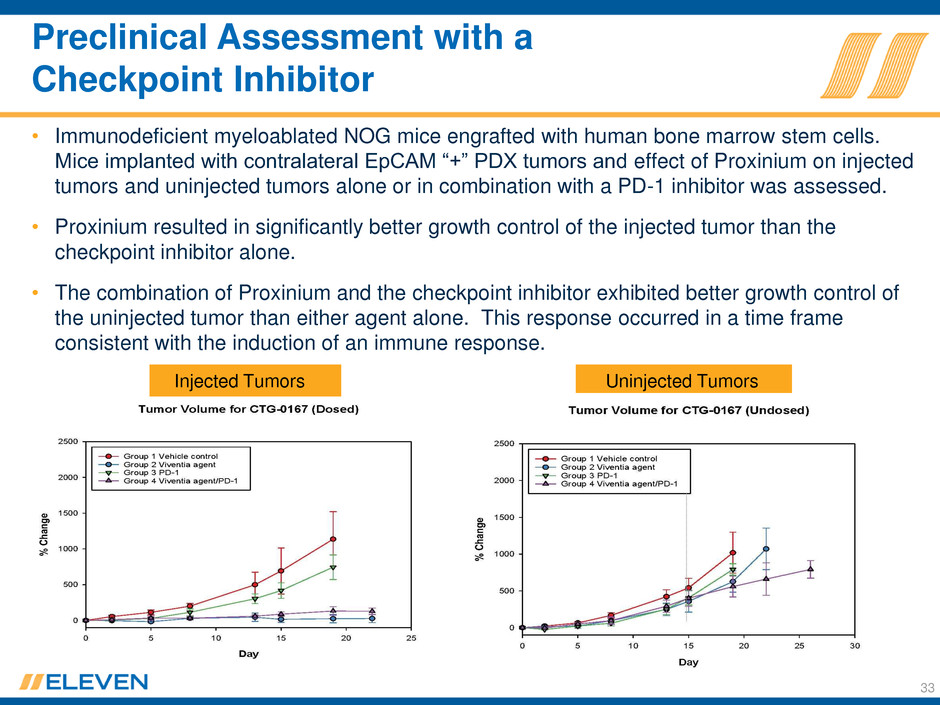
Preclinical Assessment with a
Checkpoint Inhibitor
• Immunodeficient myeloablated NOG mice engrafted with human bone marrow stem cells.
Mice implanted with contralateral EpCAM “+” PDX tumors and effect of Proxinium on injected
tumors and uninjected tumors alone or in combination with a PD-1 inhibitor was assessed.
• Proxinium resulted in significantly better growth control of the injected tumor than the
checkpoint inhibitor alone.
• The combination of Proxinium and the checkpoint inhibitor exhibited better growth control of
the uninjected tumor than either agent alone. This response occurred in a time frame
consistent with the induction of an immune response.
Injected Tumors Uninjected Tumors
33
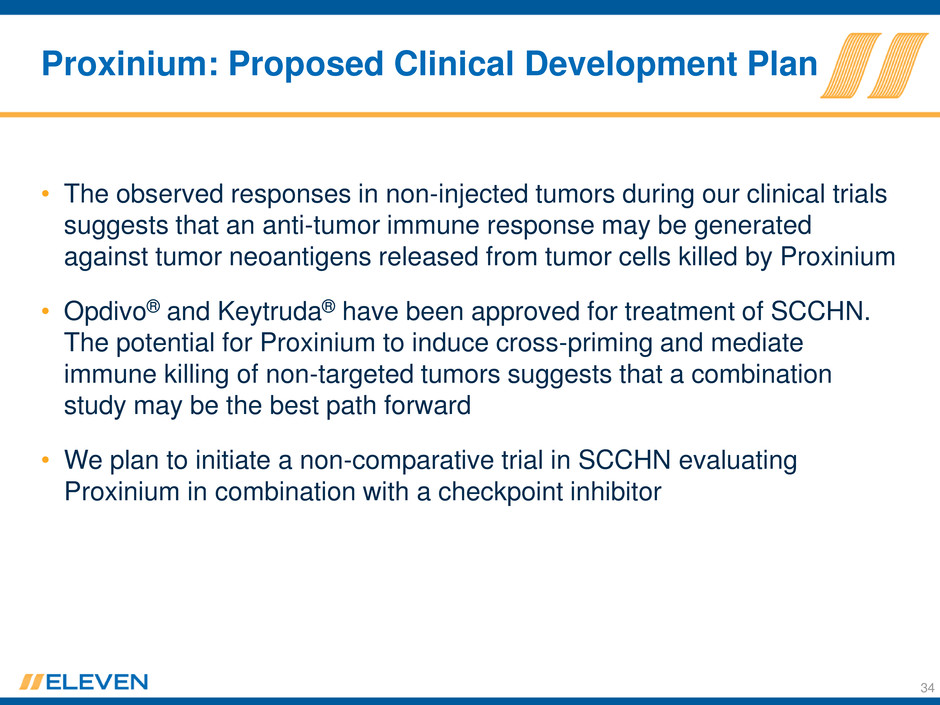
Proxinium: Proposed Clinical Development Plan
• The observed responses in non-injected tumors during our clinical trials
suggests that an anti-tumor immune response may be generated
against tumor neoantigens released from tumor cells killed by Proxinium
• Opdivo® and Keytruda® have been approved for treatment of SCCHN.
The potential for Proxinium to induce cross-priming and mediate
immune killing of non-targeted tumors suggests that a combination
study may be the best path forward
• We plan to initiate a non-comparative trial in SCCHN evaluating
Proxinium in combination with a checkpoint inhibitor
34

De-Immunized
Systemic
Product Pipeline
Bouganvillea sp.
deBouganin toxin
35

deBouganin Pre-clinical Overview
• Highly potent plant toxin
• Picomolar killing, avoidance of MDR, potentially effective against cancer stem cells
• Safety profile provides broad therapeutic window
• Engineered a de-immunized variant for systemic delivery
• Type 1 ribosome inactivating protein
• RNA N-glycosidase causes deadenylation of the 28S ribosome
• Blocks translation inducing apoptotic cell death
• Cell cycle independent
• Potentially effective against cancer stem cells
36

• deBouganin conjugated to
Herceptin is more potent than T-
DM1 (Herceptin-DM1)
nM
0.01 0.1 1 10
%
S
ur
vi
val
+/- S
.E
0
20
40
60
80
100
120 T-DM1
Her-deBoug
Potency against individual 3+ HER2 cell lines
nM
0.01 0.1 1 10 100 1000 10000
%
S
ur
vi
va
l +
/-
S
.E
0
20
40
60
80
100
120 T-DM1
DM1
nM
0.01 0.1 1 10 100 1000 10000
%
S
ur
vi
va
l +
/-
S
.E
0
20
40
60
80
100
120 deBoug
Herc-deBoug
• Free deBouganin does not
readily enter a cell thus
limiting off-target killing
37
deBouganin vs. DM1

nM
#
o
f m
am
m
o
sp
h
er
es
+
/-
S
.E
0
20
40
60
80
NT
T-DM1
Herc-deB
0 0.1 1 10
• Herceptin-deBouganin is
more potent than T-DM1
against tumor cells with
cancer stem cell properties
• Targeted deBouganin is designed to avoid MDR
mechanisms (e.g. PgP-1 overexpression)
Cell line MDR Status
IC50 (nM)
VB6-845 Doxorubicin Taxol
NCI-H69 w.t. 2.8 ± 0.4 63 ± 26 4
NCI-H69-LX4 MDR “+” 0.5 ± 0.1 3620 ± 345 >1000
38
Potential Advantages of deBouganin

• Completed Two Dose Cohorts in Phase 1 trial in Solid Tumor Subjects
• Primary tumor types: kidney, ovary, breast, stomach, pancreas, non small cell
lung, thyroid and colorectal
• Immunogenicity
• No significant antibody response against the de-immunized bouganin
• But 6/15 subjects (40%) exhibited immune reactivity against the Fab by week 3
• Stable disease on CT
• 5/7 subjects who completed 4 weeks of therapy
• 1/3 subjects dosed beyond the first treatment cycle showed stable disease at the
completion of the second and third cycles
• Two subjects had radiographic evidence of a reduction in tumor size
• Kidney cancer – CT reduction of target tumors (11 – 29%)
• Breast cancer – CT decrease in 4/5 measurable target lesions in the liver (4% –
15%), other non-targeted lesions were stable
• 5 SAEs reported
• Only 2 SAEs related to treatment -- both infusion related reactions
*Source: Entwistle et al. Chapter 19, Antibody-Drug Conjugates and Immunotoxins, G.L. Phillips (ed), 2013
39
VB6-845: deBouganin-EpCAM Fab

VB5-845 ( m g/mL)
0 5 10 15 20 25
M
ea
n
F
o
ld
I
n
c
reas
e
0
10
20
30
40
50
VB6-845
VB6-845d
VB6-845d retains binding
specificity in pre-clinical study
%
p
o
sit
ive
-d
o
n
o
rs
0
5
10
15
20
25
30
95
100
WT D
22%
4%
845 Fab
845d Fab
Successful de-immunization of
845 Fab to create VB6-845d
<10% = low
immunogenic
potential
40
VB6-845: Intend to File IND with FDA in 2017

Vicinium NMIBC Phase 3 initiation 2016
Initiate Proxinium / Checkpoint SCCHN
Phase 2 trial
1H 2017
Vicinium NMIBC Phase 3 full enrollment 1H 17
Submit IND to FDA for systemic product
candidate VB6-845d
2017
Vicinium NMIBC Phase 3 topline data 1H 18
Upcoming Milestones
41
